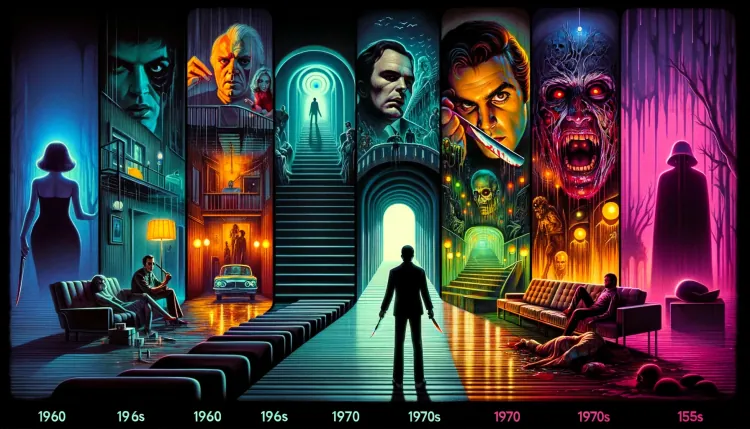From Giallo to Modern Terror: Tracing the Evolution of Italian Horror Cinema
The rich history of Italian horror cinema, from its early 20th-century beginnings through the iconic giallo era to contemporary influences

-
Introduction
- Overview of the unique position and influence of Italian horror cinema in global film history.
-
Beginnings: The 1910s to the 1950s
- Early Italian horror influences from the silent film era.
- Transition to explicit horror themes in the post-war period.
-
The 1960s: The Rise of the Giallo
- Introduction and definition of the giallo genre.
- Impact of Mario Bava and his seminal works like "Black Sunday."
-
The 1970s: The Golden Age
- Dominance of Dario Argento and his contributions, including "Suspiria."
- Lucio Fulci's influence with his "Gates of Hell" trilogy.
-
The 1980s and Beyond: Decline and Transformation
- Challenges faced by the Italian horror industry in the 1980s.
- Efforts to revitalize the genre by directors like Michele Soavi.
-
Contemporary Scene: Revival and Innovation
- Revival of interest in classic Italian horror films.
- Characteristics of modern Italian horror films, blending psychological horror with social commentary.
-
Conclusion
- Summary of the evolution and enduring impact of Italian horror cinema.
-
FAQs
- What defines a giallo film?
- Why is "Suspiria" considered a landmark in horror cinema?
- Who are some contemporary Italian horror filmmakers to watch?
Introduction Italian horror cinema, renowned for its stylistic flair and intense narratives, holds a distinctive place in the panorama of global film. From its early explorations in the silent era to the influential giallo period and beyond, Italian horror has continuously captivated audiences and inspired filmmakers worldwide.
Beginnings: The 1910s to the 1950s The roots of Italian horror cinema can be traced back to films like "L'Inferno" (1911), which, while not horror in the conventional sense, utilized disturbing and fantastical imagery indicative of later horror aesthetics. The genre began to take a more explicit form post-World War II, incorporating gothic and macabre elements that would become staples of Italian horror.
The 1960s: The Rise of the Giallo The 1960s heralded the arrival of giallo, a genre blending mystery and horror with a penchant for aesthetic violence and eroticism. Mario Bava's "Black Sunday" and "Blood and Black Lace" were pioneering, introducing innovative uses of color and lighting that would define the genre.
The 1970s: The Golden Age This era was marked by the works of Dario Argento and Lucio Fulci, with films that pushed the boundaries of horror aesthetics. Argento's "The Bird with the Crystal Plumage" and "Suspiria" were notable for their vivid visual style and suspenseful storytelling, while Fulci's "Gates of Hell" trilogy, especially "The Beyond," became renowned for its grotesque surrealism and intense imagery.
The 1980s and Beyond: Decline and Transformation The 1980s saw a decline in the prominence of Italian horror, challenged by economic difficulties and competition from Hollywood. Nonetheless, directors like Michele Soavi sought to keep the genre relevant, blending traditional elements with modern sensibilities in films like "The Church."
Contemporary Scene: Revival and Innovation Recently, there has been a resurgence of interest in Italian horror, particularly in the cult appeal of giallo films. Modern Italian horror films often incorporate psychological elements and social commentary, reflecting contemporary societal concerns.
Conclusion Italian horror cinema has demonstrated remarkable adaptability and influence throughout its history. From the visually striking films of the giallo era to the introspective and innovative works of today, the genre continues to evolve, offering a unique blend of terror and style that remains influential in global cinema.
FAQs
- What defines a giallo film?
- Giallo films are characterized by their blend of mystery and horror, notable for their graphic violence, complex plots, and often erotic undertones.
- Why is "Suspiria" considered a landmark in horror cinema?
- "Suspiria" is celebrated for its stylistic innovation, particularly its use of vibrant colors and soundtrack, which create a uniquely atmospheric and terrifying experience.
- Who are some contemporary Italian horror filmmakers to watch?
- Filmmakers like Luca Guadagnino, who directed the "Suspiria" remake, and other directors emerging from the Italian independent cinema scene, are revitalizing the genre with new perspectives and techniques.
Explore more about the thrilling world of Italian horror cinema and its iconic films at Kiksee Magazine.
What's Your Reaction?






















